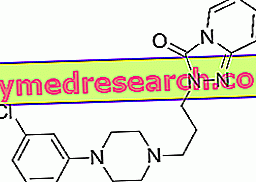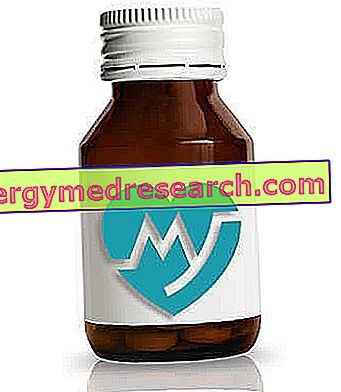Trazodone is a drug with antidepressant action. It is probably best known under the trade name Trittico ®. It was discovered in the 1970s following laboratory research conducted by the pharmaceutical company Angelini.

Trazodone - Chemical Structure
Besides having antidepressant action, trazodone also has anxiolytic and hypnotic effects.
Indications
For what it uses
The use of trazodone is indicated for the treatment of:
- Depressive disorders, with or without anxiety component;
- Adjuvant in pain therapy (injectable trazodone);
- Strengthening of anesthesia (injectable trazodone).
Furthermore, trazodone has been shown to be effective in the treatment of panic attacks, diabetic neuropathy and alcohol or benzodiazepine cessation.
Warnings
Depression is related to an increased risk of suicidal thoughts, self-harm and suicide attempts. The improvement of these symptoms may not occur immediately after taking trazodone, therefore, careful monitoring of patients is necessary until such improvement occurs.
Trazodone should not be used in children and adolescents under 18 years of age.
In the event of jaundice, trazodone treatment should be discontinued immediately.
Administration of trazodone in patients with schizophrenia - or other psychotic disorders - may lead to worsening psychotic symptoms.
Patients receiving trazodone entering a manic phase should stop taking the drug.
In patients who are on antihypertensive drugs - and who are taking trazodone - a reduction in the dose of antihypertensives administered may be necessary.
The use of trazodone should be carried out with caution in patients suffering from previous cardiovascular pathologies, including those that cause an increase in the QT interval (the length of time that the ventricular myocardium takes to depolarize and repolarize).
A lot of caution should be used when trazodone is administered in patients with:
- Epilepsy;
- Hepatic and / or renal insufficiency, especially if severe;
- Heart disease;
- Hyperthyroidism;
- Urination disorders;
- Acute angle glaucoma.
If you suffer from any of these conditions, you must inform your doctor before starting trazodone therapy.
Trazodone may have a minor or moderate influence on the ability to drive and use machines, so caution is advised.
Interactions
Trazodone can amplify the sedative effects induced by antipsychotic, anxiolytic, hypnotic, sedative and antihistamine drugs.
Trazodone metabolism can be increased by oral contraceptives, phenytoin (an antiepileptic drug) and barbiturates . Cimetidine (a drug used to treat gastric ulcer), on the other hand, can decrease the metabolism of trazodone.
Trazodone is mainly metabolised by the hepatic enzyme CYP3A4, so attention should be paid to the simultaneous administration of trazodone and drugs capable of inhibiting this enzyme, such as, for example:
- Ketoconazole and itraconazole (antifungal drugs);
- Erythromycin (an antibiotic);
- Ritonavir and indinavir (antiviral drugs);
- Nefazodone (another antidepressant).
Concomitant administration of trazodone and carbamazepine (an anti-epileptic drug) reduces the plasma concentration of trazodone.
Concomitant intake of trazodone and tricyclic antidepressants ( TCA ) should be avoided due to interactions that may occur. The same applies to the simultaneous administration of trazodone and MAO (monoamine oxidase inhibitors).
The co-administration of trazodone and drugs that increase the serotonin signal - such as, for example, selective serotonin reuptake inhibitors ( SSRIs ) - can promote the emergence of serotonin syndrome. Furthermore, the concomitant administration of trazodone and fluoxetine (an SSRI) may cause worsening of the side effects induced by the trazodone itself.
Simultaneous use of trazodone and antipsychotics, such as - for example - chlorpromazine, fluphenazine and perphenazine, can cause severe orthostatic hypotension (ie a sharp drop in blood pressure following the transition from a sitting or lying position to an upright position).
Trazodone is able to enhance the sedative effects of alcohol, so contemporary intake should be avoided.
Trazodone can alter the metabolism of levodopa (a drug used to treat Parkinson's disease).
The use of trazodone together with drugs capable of prolonging the QT interval may increase the risk of ventricular arrhythmias.
Trazodone may inhibit the action of clonidine (a drug used primarily in the treatment of hypertension).
Concomitant use of trazodone and warfarin (an anticoagulant) may change the prothrombin time.
Trazodone-induced side effects may increase if it is given at the same time as St. John's wort (or St. John's wort, a plant with antidepressant properties).
Trazodone can cause an increase in blood levels of digoxin (a drug used to increase the strength of cardiac contraction) and phenytoin .
Side effects
Like any other drug, trazodone can also cause a number of side effects. However, the adverse effects do not always occur all with the same intensity in each patient. This happens due to the different sensitivity that each individual has towards the drug.
The following are the main side effects induced by the drug.
Blood and lymphatic system disorders
Treatment with trazodone can cause dysfunctions of the system responsible for the production of blood cells (hemolymphopoietic system), such dysfunctions can cause:
- Anemia (reduced amount of hemoglobin in the blood);
- Leukopenia (reduced number of white blood cells) with consequent increased susceptibility to infection contraction;
- Plateletopenia (reduced number of platelets) leading to bruising and abnormal bleeding with an increased risk of bleeding.
Endocrine disorders
Trazodone therapy can trigger the syndrome of inappropriate secretion of the antidiuretic hormone (SIADH).
Nutrition and metabolism disorders
Trazodone can cause changes in sodium levels in the bloodstream, can lead to a drop in body weight and the onset of anorexia. It can also cause an increase in appetite.
Psychiatric disorders
Trazodone can cause psychiatric disorders, such as:
- Succidary ideas and / or suicidal behavior;
- Confusion;
- Insomnia;
- Anxiety;
- Disorientation;
- Mania;
- Nervousness;
- agitation;
- Delirium;
- Aggression;
- Hallucinations;
- Nightmares.
Nervous system disorders
Treatment with trazodone may cause:
- Convulsions;
- Malignant neuroleptic syndrome;
- Dizziness;
- dizziness;
- Headache;
- Drowsiness;
- Restlessness;
- Tremor;
- Reduced supervision;
- Memory disorders;
- Expressive aphasia (inability to understand written and spoken language);
- Paresthesia (alteration of the sensitivity of the limbs or other parts of the body);
- Dystonia (a particular type of movement disorder).
Cardiac disorders
Treatment with trazodone may give rise to heart problems, such as bradycardia, tachycardia and electrocardiogram abnormalities.
Vascular pathologies
Treatment with trazodone may cause hypotension, orthostatic hypotension and syncope (transient loss of consciousness caused by cerebral hypoperfusion).
Gastrointestinal disorders
After taking trazodone, nausea, vomiting, dry mouth, diarrhea or constipation, dyspepsia, stomach pain, gastroenteritis, increased salivation and paralytic ileus may occur.
Hepatobiliary disorders
Trazodone can cause changes in blood levels of transaminases, changes in liver function and intrahepatic cholestasis. Furthermore, the drug can cause jaundice and hepatotoxicity.
Skin and subcutaneous tissue disorders
Treatment with trazodone can promote the appearance of rashes, itching and hyperhidrosis.
Other side effects
Other adverse effects that may occur following the use of trazodone are:
- Allergic reactions in sensitive subjects;
- Decreased libido, but in a reduced way compared to other antidepressant drugs;
- Blurred vision;
- Myoclonia (short and involuntary contraction of a muscle or a group of muscles);
- Alterations in the sense of taste;
- Nasal congestion and dyspnea;
- Chest pain;
- Myalgia and / or arthralgia;
- Dorsal and / or limb pain;
- Urination disorders;
- Weakness;
- Fatigue;
- Temperature;
- Edema;
- Flu-like symptoms;
- Priapism (painful and prolonged erection in the absence of sexual arousal).
Overdose
There is no specific antidote for trazodone overdose. The use of activated charcoal and a gastric lavage may be useful. The typical symptoms of trazodone overdosage are nausea, vomiting, drowsiness and dizziness, but more severe cases have also been reported involving seizures, tachycardia, hypotension, respiratory failure and even coma.
In any case, if you suspect you have taken an overdose of medication, you should immediately contact the nearest hospital.
Action mechanism
The antidepressant, anxiolytic and sedative action of trazodone seems to be mainly due to the antagonist action of the drug on serotonin 5-HT 2A receptors. In fact, these receptors appear to be involved in both depressive and psychotic conditions.
Furthermore, trazodone exerts a weak inhibition of SERT, the transporter responsible for the re-uptake of serotonin within the presynaptic termination. The inhibition of serotonin reuptake causes it to remain in the synaptic wall (the space present between presynaptic and postsynaptic nerve termination) for a prolonged period, thus causing an increase - albeit a mild one - in serotonin transmission.
Mode of Use - Posology
Trazodone is available for oral administration as tablets or oral drops. Furthermore, it is also available in vials for intramuscular or intravenous administration.
The trazodone dosage must be established by the physician on an individual basis for each patient.
It should be borne in mind that in patients with liver disease - especially if severe - periodic monitoring of liver function may be necessary.
The dosages of the drug normally used are given below.
Oral administration
In adults, the usual dose of trazodone is 75-150 mg per day, to be given as a single dose in the evening before bedtime. The dose can be increased up to 300 mg of drug, to be taken in divided doses during the day.
In hospitalized patients the dosage can also be 600 mg of active ingredient per day in repeated doses.
Generally, in the very elderly patients an adjustment of the administered dose is necessary.
Intramuscular or intravenous administration
For the treatment of depression, the usual amount of trazodone used is 100-200 mg of drug diluted in 250-500 ml of physiological solution, to be administered by slow intravenous infusion twice a day.
For complementary pain therapy, the usual dose of trazodone is 25-50 mg of drug per day, to be administered intramuscularly or by intravenous injection or infusion, once or twice a day, at the discretion of the doctor.
For the potentiation of anesthesia, the dose of trazodone usually used is 0.5-1 mg / kg of body weight, to be administered by bolus into a vein - or by intravenous infusion - one or more times during the course of the operation, depending on its duration.
In very elderly patients a reduction in the dose of the drug administered may be necessary.
Pregnancy and breastfeeding
Trazodone should not be used during pregnancy, except in cases where the doctor does not consider it absolutely necessary and only after a careful evaluation of the risk-benefit ratio. In the case of trazodone intake by the expectant mother in the late stages of pregnancy, newborns should be carefully monitored to identify any adverse effects.
Since trazodone could be excreted in breast milk, the use of the drug by breast-feeding mothers is not recommended.
Contraindications
The use of trazodone is contraindicated in the following cases:
- Known hypersensitivity to trazodone;
- In the case of patients who have suffered from acute myocardial infarction;
- In the event of alcoholic intoxication;
- In case of hypnotic drug poisoning;
- In children and adolescents under the age of 18;
- In pregnancy and during lactation.



